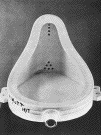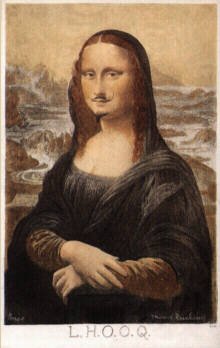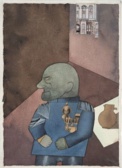

Many artists associated with this movement later became associated with Surrealism. Many other movements have been influenced by Dada, including Pop Art and Fluxus.
Examples of Dadaist works:
Francis Picabia (born "Francis Martinez de Picabia") (French, 1879-1953; active in New York and Barcelona, 1913-17), Dada Movement, 1919, ink on paper, 20 1/8 x 14 1/4 inches (51.1 x 36.2 cm), Museum of Modern Art, NY.
Francis Picabia, Take Me There (M'amenez-y), 1919-20, oil on cardboard, 50 3/4 x 35 3/8 inches (129.2 x 89.8 cm), Museum of Modern Art, NY.
Francis Picabia, L'Oeil Cacodylate, 1921, oil on canvas, with collaged photographs, postcards and other papers, 148.6 x 117.4 cm, Centre Georges Pompidou, Paris.
Francis Picabia, Conversation II, c. 1922, watercolor on composition board, 17 7/8 x 23 7/8 inches (45.4 x 60.6 cm), Museum of Modern Art, NY. See torso.

Theo van Doesburg (born Christian Emil Kuepper [or Küpper]) (Dutch, 1883-1931) with Kurt Schwitters (German, 1887-1948), Kleine Dada Soirée, 1922, lithograph, sheet: 11 7/8 x 11 7/8 inches (30.2 x 30.2 cm), Museum of Modern Art, NY.
Jean Arp (born "Hans Arp") (French, 1886-1966), Abstract Composition, 1915, wood relief construction, Tehran Museum of Contemporary Art, Iran.
Jean Arp, Collage Arranged According to the Laws of Chance, 1916-17, torn-and-pasted papers on gray paper, 19 1/8 x 13 5/8 inches (48.6 x 34.6 cm), Museum of Modern Art, NY. Arp was a founding member of the first Dada group that coalesced in Zurich in 1916 around the Cabaret Voltaire of Hugo Ball, the poet and performer. "Dada," wrote Arp, "wished to destroy the hoaxes of reason and to discover an unreasoned order." While this work is far less violent than some of the rhetoric of Dada, Arp's use of serendipitous composition here embodies what has been called the heart of Dada practice: the gratuitous act. See aleatory and collage.
Jean Arp, Trousse d'un Da, 1920-1921, assemblage of driftwood nailed onto wood with some remains of old painting, 38.7 x 27 x 4.5 cm, Georges Pompidou Center, Paris. See wood.

Raoul Hausmann (Austrian, 1886-1971), Mechanical Head [or, The Spirit of Our Time],
1919, assemblage: the
head of a mannequin in
wood, with diverse objects attached
to it (including a leather pocketbook,
a collapsing aluminum cup, brass and cardboard
labels, part of a telescope, a pipe, white cardboard with the
figure 22, a part of a dressmaker's measure, a watch gear-wheel,
a printing roller), 12 5/8 x 9 inches (32.5 x 21 x 20 cm), Centre
Georges Pompidou, Paris. See Austrian art.

Raoul Hausmann, Untitled, undated, lithograph and photographic
collage
on paper, 31.8 x 25.4 cm, Tate
Gallery, London.
Marcel Duchamp (American, born France, 1887-1968), Coffee Mill, 1911, oil and pencil on board, 33.0 x 127 cm, Tate Gallery, London.
Marcel Duchamp, Bicycle Wheel, 1913 / 1964, metal, painted wood, 126.5 x 31.5 x 63.5 cm, Georges Pompidou Center, Paris. Duchamp called this "an assisted readymade."
Marcel Duchamp, 3 Standard Stoppages, Paris 1913-14, wooden box 11 1/8 x 50 7/8 x 9 inches (28.2 x 129.2 x 22.7 cm), with three threads 39 3/8 inches (100 cm), glued to three painted canvas strips 5 1/4 x 47 1/4 inches (13.3 x 120 cm), each mounted on a glass panel 7 1/4 x 49 3/8 x 1/4 inches (18.4 x 125.4 x 0.6 cm), three wooden slats 2 1/2 x 43 x 1/8 inches (6.2 x 109.2 x 0.2 cm), shaped along one edge to match the curves of the threads.
Marcel Duchamp, Network of Stoppages, Paris 1914, oil and pencil on canvas, 58 5/8 inches x 6 feet 5 5/8 inches (148.9 x 197.7 cm), Museum of Modern Art, NY.
Marcel Duchamp, The Bride Stripped Bare by Her Bachelors, Even [aka Large Glass] 1915-1923, oil and other media, 9 feet 1 1/4 inches x 5 feet 9 inches, Philadelphia Museum of Art. It took eleven years to bring this work to what Duchamp called a state of "final incompletion." Only when it was accidentally cracked in 1926 did Duchamp announce that it was "finished."

Marcel Duchamp, Fountain, 1917, white glazed ceramic
plumbing fixture and painted signature, readymade porcelain
urinal on its back, 63 x 48 x 35 cm. The urinal, purchased from
"Mott Works" company in New York and signed "R.
Mutt," was submitted to the jury-free 1917 Independents
exhibition but was suppressed
by the hanging committee. This is a photograph of either the
second version of 1951 or the third of 1964. The Georges Pompidou
Centre in Paris publishes a color photo of it. See anti-art and fountain.
Marcel Duchamp, Hat Rack, 1917 / 1964, wood, 27 x 44.5 cm, Georges Pompidou Center, Paris.
Marcel Duchamp, Handmade Stereopticon Slide, (c. 1918-19), pencil on gelatin silver prints mounted on black-paper-surfaced board, 2 5/8 x 6 3/4 inches (6.8 x 17.2 cm), Museum of Modern Art, NY. See stereoscopic vision.

Marcel Duchamp, L.H.O.O.Q., 1919, rectified readymade, pencil
on a reproduction — a chromolithograph, 7 3/4 x 4 7/8 inches, private collection,
Paris. As if the addition of mustache and beard weren't enough
of a poke at this most famous of paintings, the letters Duchamp
penciled — L.H.O.O.Q. — at the bottom of his altered image
are meaningless in themselves, but when read aloud in French,
make the sound of "Elle a chaud au cul," meaning, "She
has a hot ass."
In 1965 Duchamp produced L.H.O.O.Q. Shaved, New York, 1965, playing card with colored ink on printed invitation, 8 1/4 x 5 3/8 inches (21 x 13.8 cm), Museum of Modern Art, NY.
See aerial
perspective, anti-art, Renaissance,
and sfumato.
Marcel Duchamp, Fresh Widow, 1920, replica 1964, mixed media, 78.9 x 53.2 x 9.9 cm, Tate Gallery, London.
Marcel Duchamp, Monte Carlo Bond (No. 12), 1924, cut-and-pasted gelatin silver prints on lithograph with letterpress, 12 1/4 x 7 1/2 inches (31.2 x 19.3 cm), Museum of Modern Art, NY.
Marcel Duchamp, Rotary Demisphere (Precision Optics), Paris 1925, painted wood demisphere fitted on velvet disk, copper collar with plexiglass dome, motor, pulley, and metal stand, 58 1/2 x 25 1/4 x 24 inches (148.6 x 64.2 x 60.9 cm), Museum of Modern Art, NY.
Marcel Duchamp, La Mariée mise à nu par ses célibataires, même (The Bride Stripped Bare by Her Bachelors, Even [The Green Box]) by the artist, 1934, illustrated book with ninety-four collotypes, page: 2 11/16 x 3 13/16 to 12 3/8 x 9 1/2 inches (7.4 x 9.7 to 31.4 x 24.2 cm); box: 13 1/16 x 11 x 1 inch (33.2 x 27.9 x 2.5 cm); edition: 320; printer: Vigier et Brumssen, Paris; publisher: Édition Rrose Sélavy (the artist), Paris; Museum of Modern Art, NY.
Marcel Duchamp, Box in a Valise (From or by Marcel Duchamp or Rrose Sélavy), 1935-41, leather valise containing miniature replicas, photographs, color reproductions of works by Duchamp, and one "original" drawing [Large Glass, collotype on celluloid, 7 1/2 x 9 1/2 inches (19 x 23.5 cm)], 16 x 15 x 4 inches (40.7 x 38.1 x 10.2 cm), Museum of Modern Art, NY.
Marcel Duchamp, Rotorelief (Optical Discs), 1935-1953, two editions, two circular discs magnetized 1 inch and 2 inch dark borders, drawings on 6 discs, both sides 7 7/8 inch diameter, casing 14 3/4 x 14 3/4 inches. When viewed (preferably with one eye) at a rotating speed of 40-60 rpm, the disks present an optical illusion of depth, and in a few cases, of three-dimensional objects: a fishbowl a light bulb, a balloon.
[New York: VVV], 1942-1944, publisher,
VVV, No. 1 (June 1942)-no. 4 (Feb. 1944),
serial; 4 no. in 3: illustrations
(some colored); 28 cm., irregular; Metropolitan Museum of Art,
NY.
Illustrated:
On the left is Marcel Duchamp's readymade of a female imprisoned behind
chicken wire on the last page and back cover of VVV, No.
2/3. On the right is the cover of No. 4 of VVV.
Marcel Duchamp, Wedge of Chastity, New York 1954, plaster in two sections, partly painted, 2 3/4 x 3 7/8 x 2 1/2 inches (6.9 x 10 x 6.1 cm), Museum of Modern Art, NY.
Marcel Duchamp, Torture-Morte, 1959, painted plaster and flies, on paper mounted on wood, 11 5/8 x 5 5/16 x 2 3/16 inches (29.5 x 13.4 x 10.3 cm), Centre Georges Pompidou, Paris. The title is a pun on "nature morte," the French term for still life.
Kurt Schwitters (German, 1887-1948; in Norway 1937-40; in England 1940-48), Revolving (Das Kreisen), 1919, relief construction of wood, metal, cord, cardboard, wool, wire, leather, and oil on canvas, 48 3/8 x 35 inches (122.7 x 88.7 cm), Museum of Modern Art, NY. (A fine point: Someone at the Museum of Modern Art describes this as a "relief construction," and this may be more appropriate than calling it a collage. Is it more a construction because its components are joined by nails and wire than by adhesives? From this photo of it, Revolving greatly resembles what might just as appropriately be described as a collage. If these terms overlap, how much do they?!)

Kurt Schwitters, Merz Picture 32A (The Cherry Picture),
1921, cloth, wood, metal,
fabric, cut-and-pasted papers,
cork, gouache,
oil, and ink
on cardboard, 36 1/8
x 27 3/4 inches (91.8 x 70.5 cm), Museum of Modern Art, NY.
Kurt Schwitters, Measure, 1932, drawing on printed paper, 15.7 x 12.5 cm, Tate Gallery, London. Schwitters started to make found works in the early 1920s. For Measure, Schwitters added some line drawing to an image he found in a magazine.
Kurt Schwitters, Magic, c. 1936-40, collage on paper, support: 13.1 x 10.6 cm, Tate Gallery, London.
Kurt Schwitters, Opened by Customs, 1937-8, paper collage, oil and pencil on paper, 33.1 x 25.3 cm, Tate Gallery, London.
Kurt Schwitters, Picture with Basket Ring (Bild mit Korbring), 1938, assemblage: wood, rattan ring, paper, iron and steel nails on wood, 15 x 11 3/4 inches (38.1 x 29.8 cm), Museum of Modern Art, NY. (Another fine point: Someone at the Museum of Modern Art describes this as an "assemblage," and this may be more appropriate than calling it a collage. Is it more an assemblage because its components are joined by nails than by adhesives, or because its support is wood rather than paper? From this photo of it, Picture with Basket Ring resembles what might just as appropriately be described as a collage. If these terms overlap, how much do they?!)
Kurt Schwitters, The Proposal, 1942, collage on paper, 31.9 x 39.5 cm, Tate Gallery, London.
Kurt Schwitters, (Relief in Relief), c. 1942-5, oil on wood and plaster, 49.5 x 41.3 x 10.2 cm, Tate Gallery, London.
Kurt Schwitters, Red Wire Sculpture, 1944, painted metal, stone, mixed media, 25.0 x 13.0 x 13.0 cm, Tate Gallery, London. See found material and wire.
Kurt Schwitters, Lofty, c. 1945-7, painted plaster, 25.2 x 16.0 x 13.0 cm, Tate Gallery, London.
Kurt Schwitters, Untitled (Ochre), c. 1945-7, painted plaster and stone, 9.5 x 22.6 x 15.0 cm, Tate Gallery, London.
Kurt Schwitters, NB, 1947, collage.

Sophie Taeuber-Arp (born "Sophie-Henriette
Taeuber") (French, born Switzerland, 1889-1943), Head,
c. 1918 - 1919, painted wood,
34 x 20 x 20 cm, Georges Pompidou Center, Paris.

![]()

Sophie Taeuber-Arp, Dada Head, 1920, painted wood with glass beads on wire, height 9 1/4 inches (23.5 cm).
Sophie Taeuber-Arp, Draft for the tearoom on the ground floor of the Café Aubette, 1926?, gouache, pencil and ink.
Man Ray (born Emmanuel Rudnitsky) (American, 1890-1976), Compass, 1920, gelatin silver print, 11.7 x 8.6 cm (4 5/8 x 3 3/8 inches), Metropolitan Museum of Art, NY. See photography.
Man Ray, Return to Reason, 1921, oil on canvas, 14 5/8 x 9 7/8 inches, Minneapolis Institute of Arts. See helix.
Man Ray, Indestructible Object, 1923, replica 1965, wooden metronome and photograph, 21.5 x 11.0 x 11.5 cm, Tate Gallery, London. Indestructible Object is a assisted readymade.
Otto Dix (German, 1891-1969), Erinnerung an die Spiegelsäle von Brüssel (A Memory of the Glass House in Brussels), 1920, oil and glass on a sheet of silver on canvas, 124 x 80.4 cm, Georges Pompidou Center, Paris.
Max Ernst (German, 1891-1976), Aquis submersus, 1919, oil on canvas.
Max Ernst, The Hat Makes the Man, 1920, gouache, pencil, ink, and collaged collotypes, 14 x 18 inches (35.6 x 45.7 cm), Museum of Modern Art, NY.
Max Ernst and Hans (aka Jean) Arp (French, 1887-1976), Switzerland, Birth-Place of Dada, 1920, collage on paper.

George Grosz (born, Georg Ehrenfried Gross)
(American, born Germany, 1893-1959), Remember Uncle August, the Unhappy Inventor,
1919, oil, crayon,
papers and
five buttons sewn on canvas,
49 x 39.5 cm, Georges Pompidou Center, Paris.

George Grosz, "The Convict": Monteur John Heartfield after Franz Jung's Attempt to Get Him Up on His Feet, 1920, watercolor, pencil, cut-and-pasted postcards, and halftone relief on paper, 16 1/2 x 12 inches (41.9 x 30.5 cm), Museum of Modern Art, NY. See collage.
Marcel Janco (Romanian, 1895-1984), Mask,
1919, paper, cardboard,
twine, gouache,
and pastel.
Also see aleatory and aleatoric,
anomaly, blot,
Metaphysical Painting, readymade, and voyeurism.
https://inform.quest/_art
Copyright © 1996-![]()